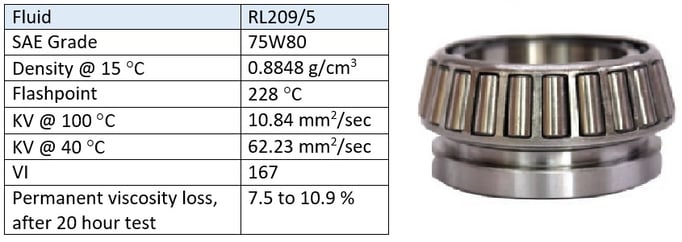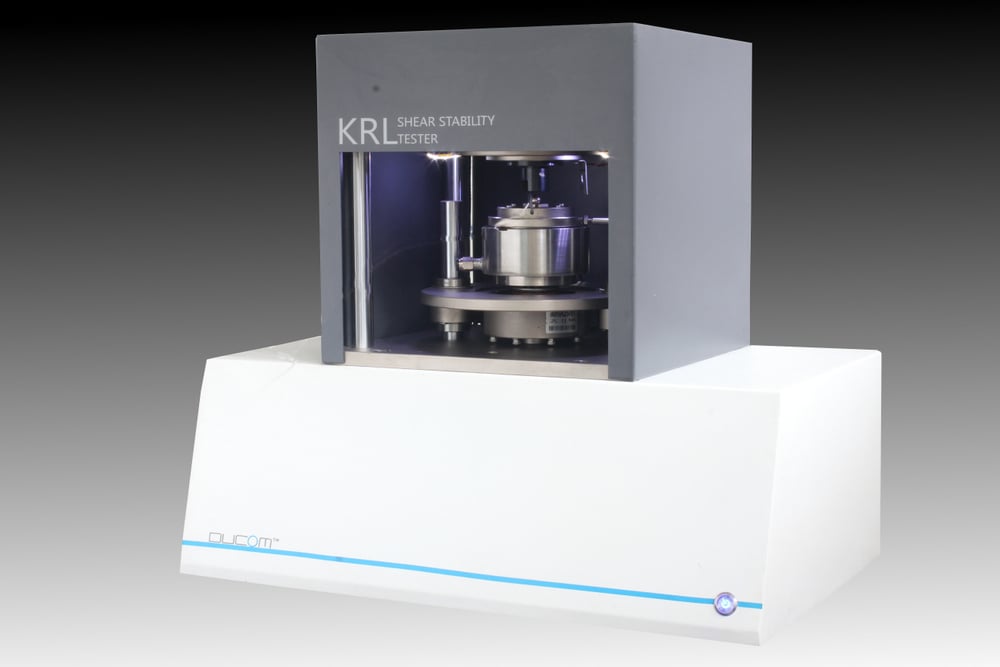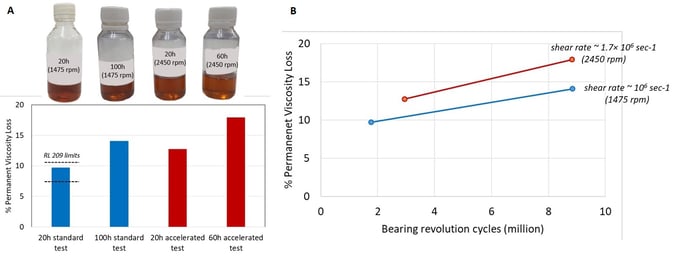
The KRL shear stability test (CEC L-45-99) is one of the most severe test to evaluate permanent viscosity loss of lubricants due to the high stresses (operating in the elastohydrodynamic regime) and long duration shearing (20 hours). In reality, much longer tests of 100 hours or more are often conducted to evaluate the performance of viscosity index improvers as these correlate better with field data (Reference - "Impact of Viscosity Modifiers on Gear Oil Efficiency and Durability", 2013 SAE, Lubrizol). In these extended duration tests load, speed and temperature limits comply with the CEC guidelines. Could the test duration be reduced while still providing reliable information on the shear stability of lubricants ? In this report, we explore the effect of speed on accelerated endurance testing of lubricants in the elastohydrodynamic regime.
MATERIALS AND METHODReference fluid (RL 209) provided by CEC was used as it had a well defined precision statement for % viscosity loss after a 20 hour standard test (Table 1). A qualified taper roller bearing (SKF 32008X) was used for all the tests.

Table 1. Reference fluid RL 209 and qualified taper roller bearing SKF 32008X
Ducom standalone KRL shear stability tester with a unique inline friction torque measurement module was used. The speed of the motor was varied using a variable frequency drive.

Ducom standalone KRL shear stability tester is automated and compact and features inline torque measurement for hundreds of hours of testing.
The test conditions are indicated in Table 2. For all tests, the CEC L-45-99 protocol which involved pre-heating the oil to 50 °C before shearing.

Table 2. Standard and accelerated KRL tests. The total number of bearing revolution cycles is indicated.
Tests #1 and #2 were run as per standard load, speed and temperature conditions except that test #2 was for 100 hours. The accelerated tests #3 and #4 were run at 2450 rpm for 20 hours and 60 hours respectively. Even though temperature was set at 60 °C for the accelerated test at 2450 rpm, the actual average temperature was 62.7 °C. A duration of 60 hours at 2450 rpm was chosen for test #4 to accumulate the same number of bearing revolutions ~ 8.82 million as the 100 hour test at 1475 rpm, test #2.
RESULTS
The load, speed, temperature and friction torque plots for the CEC standard 1475 rpm (Tests 1, 2) and accelerated 2450 rpm (Tests 3,4) are shown in Figure 3.

Figure 3. Load, speed, temperature and friction torque real-time plots for the CEC standard (1475 rpm) and accelerated (2440 rpm) KRL tests.
Load for all tests was maintained at 5000 ± 10 N with the servo-controlled pneumatic system well within the CEC limits of 5000 ± 200 N . The speed for the standard test was maintained at 1475 ± 5 rpm well within the CEC limits of 1475 ± 25 rpm. For the accelerated test at higher speeds, the speed was 2450 ± 30 rpm, slightly higher than the CEC limit. This was due to the specific variable frequency drive used with the KRL and can definitely be better controlled. The oil temperature for the standard test was maintained at 60 ± 1 °C as per the CEC limits. For the accelerated tests, the oil temperature was 62.7 ± 1.5 °C which was outside the CEC limits. This can be expected due to the higher shearing rate. It should noted that there are no CEC control limits for load, speed and temperature for the accelerated tests and the current data can be useful starting point towards establishing one. The friction torque during shearing for all the tests was captured in realtime and varied between 0.52 Nm to 0.73 Nm. Considering a load of 5000 N and moment arm of 0.1 m this translates into a coefficient of friction of ~ 0.003 for all tests. Though this is not a measurand as per the CEC standard, the data suggests that all tests were within the elastohydrodynamic lubrication regime and hence the high speed results were valid.
DISCUSSION
The permanent viscosity loss for all tests measured as per ASTM D445 at 100 deg C is shown in Figure 4. There was no change in visual appearance of RL 209 oil after all tests (Figure 4A)

Figure 4A. Permanent viscosity loss (%) for all tests with images of RL209 after the test. Figure 4B. Permanent viscosity loss for standard (1475 rpm) and accelerated (2450 rpm) as a function of total number of bearing revolutions.
The permanent viscosity loss for all tests was benchmarked w.r.t RL 209 viscosity loss limits between 7.5 to 10.9% (Figure 4a). The longer duration 100 hour, standard test shows higher visocity loss of 14.08%. The accelerated tests at 2450 rpm show much higher viscosity loss after 20 hours (12.75%) and 60 hours (17.91%) compared to the standard 20 and 100 hour tests. To enable fair comparison, viscosity loss was plotted against total bearing revolutions for the standard and accelerated tests (Figure 4b). The 60 hour accelerated test shows 30% higher viscosity loss compared to a 100 hour standard test even though both accumulated ~ 8.82 million cycles. This might either be related to the higher shear rates or lie within the scatter of viscosity loss. At the moment it is inconclusive due to limited data points.
Overall, acceleration of the KRL test to higher speeds reduced the test time by 40% while still providing reliable permanent viscosity loss data for a reference oil, RL 209 oil. Additional tests are in progress to establish repeatability as well as exploring even higher speed KRL testing.
What other features you would like to have in a KRL ? We are excited to hear from you. Drop us a note
USA: +1 (847) 737-1590
India: +91 (80) 4080-5555
Netherlands: +31 (85) 065 74 10